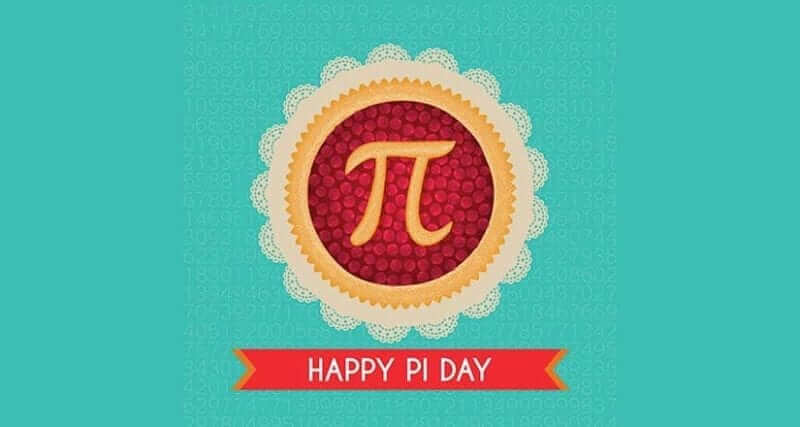13 Fun Pi Day Activities to Make This Year a Hit
March 14th (of every year) is Pi Day, and if you are a math teacher, this is your holiday. Or at least it should be. You know, 3/14, or the calendar equivalent of three-point-one-four, the popular, rounded to two decimal places version of that beloved geometry constant, Pi. No matter what the age and content you teach, this is a great day to bring some math and fun into your classroom. A famous mathematician once said, “Pi is not just a collection of random digits, Pi is a journey; an experience; unless you try to see the natural poetry that exists in Pi, you will find it very difficult to learn.” It is your job to bring your students on the journey of Pi, and I have a great place to start. As silly as it sounds, one of my favorite Pi Day activities always amazes my students and grabs their interest! This magical lightbulb moment requires a mirror, construction paper, and a marker. Simply have the students write π’s number, “3.14,” and view it in the mirror… and… ooooh, cool!… the number itself spells out “PIE” in the mirror. And so the magic of Pi Day begins.
I do things a little differently every year, but here’s a variety of fun ideas to choose from: some of my “tried and true” favorites, and others still on my wish list.
Some Pi Fundamentals
Before you check out my classroom pi celebration activities below, you may want to brush up on some circle basics. The central point of a circle is the point that defines the circle. All straight lines drawn from the edge of a circle to the middle point will be the exact same length. This line is called the radius. If you continue that line all the way through the circle from edge to edge and through the middle point, you have the diameter. And, finally, if you measure the entire distance around the circle, you get the circumference, which is just a fancy word for the perimeter of the circle. Pi (π) is simply the ratio of a circle’s circumference to its diameter. This calculation will yield an irrational, unending number with a slew of non-repeating digits after the decimal point that has been calculated to more than 10 trillion places! But, we just use π as its symbol and shorten it to 3.14. The magic of Pi is that it is constant, no matter the size of the circle, it always calculates to 3.14. An easy way to estimate the value of Pi in class is to divide a circle’s circumference by its diameter, and strings are amazingly fun and precise tools for this job! OK, Pi experts, now you that you have some well-rounded knowledge about circles you’re ready to check out some “easy as pie” ways to celebrate!
Pi Day Activities
- “Pi Luck” party- everyone has to bring something round to share! Don’t forget to measure the circumference and diameters of the circles to calculate pi!
- “Pizza Pi” party! There are few circles that score with kids better than pizza. Bring in a pizza (or several of differing sizes). Have students work in groups of two or more to measure the circumference and diameter of their pizza. As you cut the pizza for sharing, you can extend this lesson into fractions! Just a suggestion: call around to your local pizzerias. Many actually offer Pi Day discounts and many are more than willing to discount for a teacher and a classroom.
- “Cookie Pi” party! This lesson works exactly the same as the pizza, but the smaller size of the cookies and lower expense allow for each student to get their own cookie. If you make the cookies yourself, you can try different sizes to illustrate how all sizes of circles calculate to pi. Just keep those cookies round!
- Circle scavenger hunt. Time to explore the circles in our school and classrooms! When students find a circle that they want to use, have them use string to measure the circumference and diameter.
- Story time! No matter the age, all students love a good story read out loud. Sir Cumference and the Dragon of Pi: A Math Adventure is the perfect fit for the day!
- Graph it! Have students create a bar graph or a line graph of Pi. Let them fill the page with as many Pi numbers as can fit. Encourage their imagination to take over as they finish plotting- what image do they see? Is it a mountain range, is it a city skyline, is it a bunch of clouds, or a forest? Let them color and finish their Pi drawings and hang them in the classroom.
- Pi Day fundraisers! The sky’s the limit here on fundraiser options, but $3.14 sounds like the perfect price tag! Sell pizza or fruit pies. Perhaps have a pie-throwing event where students can pay to throw pies at volunteered staff members.
- Circle Collage: Give each student in the class or school a fraction of a circle to decorate. Collect the pieces and combine the circles to create a beautiful Pi Day bulletin board or hall collage!
- Pi Day chain! Assign numbers to colors and cut strips of construction paper. Then create links following the numbers of Pi, with each colored chain link representing a decimal place or a digit. This can be done in the classroom or as a school-wide event. Imagine filling the halls with hundreds of Pi’s numbers!
- “Pi-Lentines Day:” Valentine’s Day may be over, but this is a fun way to celebrate friendship, and kindness, and bring some cheer into your classroom by making “Pi-lentines” cards for each other. Students can think up phrases, or you can share ideas like, “I hope our friendship goes on forever!;” “Just let them try to divide us!;” and “Irrational and proud of it!”
- Blow a bubble and catch it on a piece of construction paper. It should leave a wet circle on the paper that students can measure. Show the relationships between circles and spheres. Bubbles are always fun!
- Pi Day plates: Have students color a paper plate and draw a pie symbol in the middle, then write as many of Pi’s numbers as they can fit along the edges.
- Pi Day bracelets: Assign colored beads to each number, similar to the Pi Day chain activity above. Cut the student’s bracelet strings to fit their wrists, so that there are different size circles within the classroom. Students can place as many of the numbers as will fit. As the bracelets are completed and knotted, challenge students to measure the circumference and diameter to calculate Pi from their very own Pi Day bracelets.





